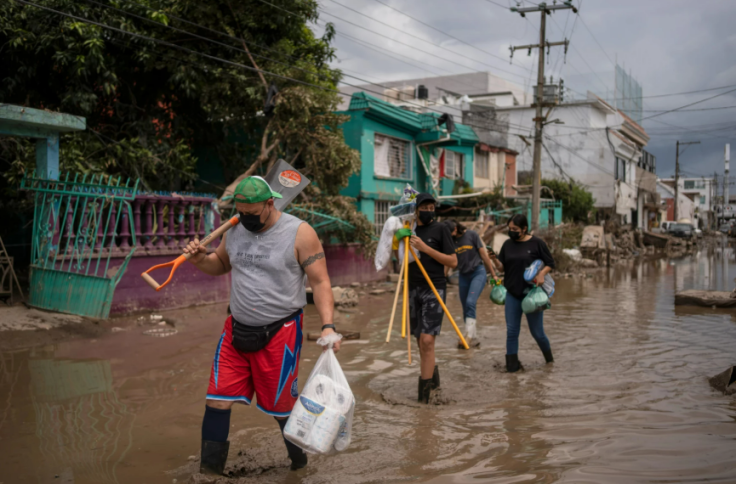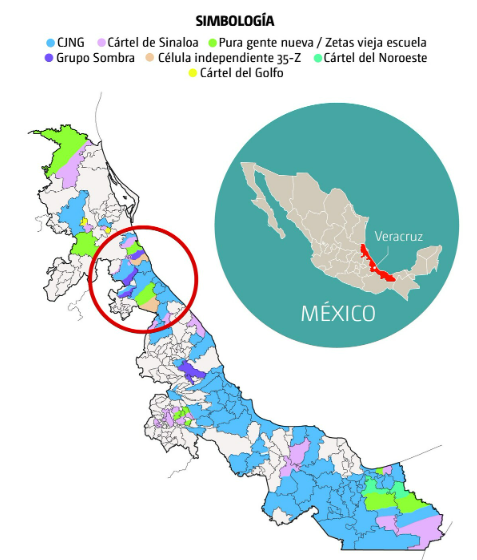
A total of 40 communities in the state of Veracruz were severely impacted by recent torrential storms that caused at least two rivers to overflow, leaving 22 of those municipalities in urgent need of government assistance.
According to Mexico's National Coordination of Civil Protection, as of now, the natural disaster has left 29 people dead and 18 others still missing in Veracruz alone.
As The Latin Times noted, criminal organizations have historically exploited moments of desperation and national emergencies to expand their influence in vulnerable areas. That pattern reemerged this week when videos shared on social media showed alleged members of the Cártel Jalisco Nueva Generación (CJNG) distributing emergency aid to residents in Álamo, Veracruz.
The aid packages, which reportedly included food and basic supplies, were marked with the cartel's insignia. In one of the videos, the men can be heard saying, "On behalf of the Lord of the Palms and the Cártel Jalisco Nueva Generación," as they hand out the bags.
“De parte del Cártel Jalisco Nueva Generación”, Sicarios del CJNG repartieron despensas a damnificados por las inundaciones en Tihuatlán, Veracruz (Información en el enlace) https://t.co/opAYchfRBn pic.twitter.com/JUh2n0bs0f
— Blog del Narco México (@blogdelnarcomx) October 14, 2025
A report from Mexico's Ministry of National Defense, leaked by the hacktivist group Guacamaya and cited by Milenio, revealed that by 2023, up to seven criminal organizations had been detected operating in Veracruz, with four of them being major cartels: CJNG, the Gulf Cartel, the Northeast Cartel, and the Sinaloa Cartel.
According to an investigation by Milenio, these groups have divided control of various municipalities across the state. CJNG, led by Nemesio Oseguera Cervantes, also known as "El Mencho," maintains a stronghold in central and southern Veracruz. Meanwhile, remnants of Los Zetas and the Gulf Cartel, which once dominated the region, have been pushed into areas near the Tamaulipas border.

As the outlet's map indicates, many of the municipalities hardest hit by the flooding lie within territories where violent clashes are common, as rival criminal groups continue fighting for control in regions such as Poza Rica, Tuxpan, and Álamo.
Milenio's report attributes the state's high level of organized crime presence to two key factors. The first is the fragmentation of the Gulf Cartel and Los Zetas, whose weakened leadership led to the rise of smaller, more violent factions such as Grupo Sombra and the Northeast Cartel.
The second factor is the relentless territorial expansion of the CJNG. According to the latest annual report by the U.S. Drug Enforcement Administration (DEA), CJNG is now considered the only cartel in history with a presence in all 32 Mexican states.
As The Latin Times highlighted in August, federal investigations have also suggested that criminal groups often operate with the help of municipal police forces and local public officials in Veracruz.
Recent outbreaks of violence in the state have intensified those suspicions.
One of the most serious incidents this year occurred in the municipality of Tuxpan, where seven inmates were killed and 11 others injured during a prison riot. As El País reported, inmates held control of the facility for over 12 hours. Videos shared on social media showed several men claiming they were being extorted by members of Grupo Sombra, prompting a federal investigation.
The ports of Veracruz, which according to prehispanic legends once supplied fresh fish daily to Tlatoani Moctezuma Xocoyotzin in what is now Mexico City, are now under the control of drug cartels. Criminal groups are drawn to the region by its strategic location near commercial ports and key trafficking routes.
© 2025 Latin Times. All rights reserved. Do not reproduce without permission.






